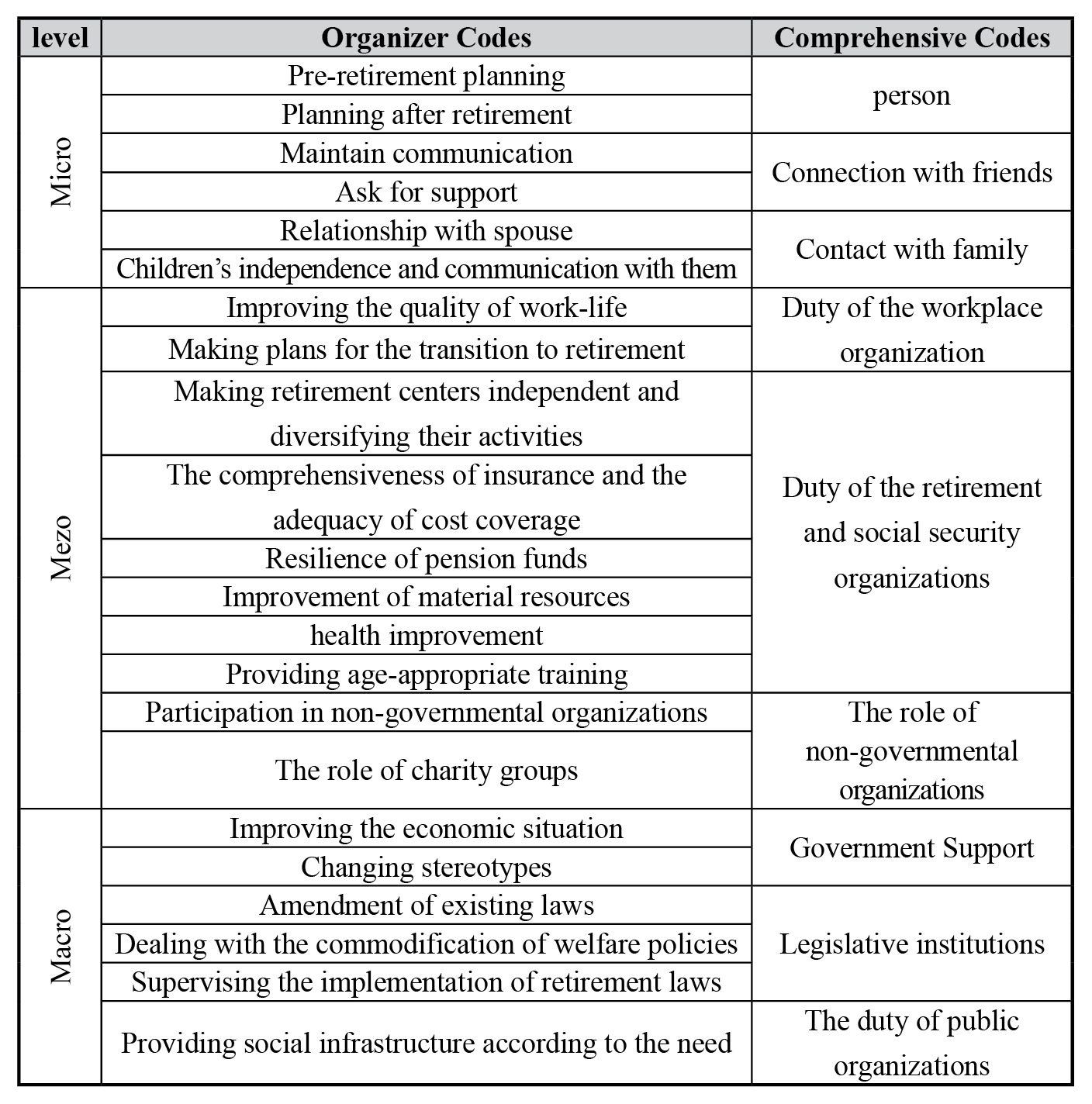Volume 25, Issue 96 (3-2025)
refahj 2025, 25(96): 213-224 |
Back to browse issues page
Download citation:
BibTeX | RIS | EndNote | Medlars | ProCite | Reference Manager | RefWorks
Send citation to:



BibTeX | RIS | EndNote | Medlars | ProCite | Reference Manager | RefWorks
Send citation to:
Amini S J, khezri F, Mohammedans M. (2025). Resilience during retirement: Presenting a multi-level pattern. refahj. 25(96), : 8 doi:10.32598/refahj.25.96.4567.1
URL: http://refahj.uswr.ac.ir/article-1-4366-en.html
URL: http://refahj.uswr.ac.ir/article-1-4366-en.html
Full-Text [PDF 433 kb]
(592 Downloads)
| Abstract (HTML) (1563 Views)
Full-Text: (337 Views)
Extended Abstract
Introduction
Resilience enables individuals and groups to maintain their identity in the face of unusual situations and potentially become stronger in difficult situations. Resilience has been used in various groups, including retirees. During retirement, aging and changing age structures of the population, changes in economic and family institutions, specific needs of this period of life, and specific issues of social security systems have created a wide range of issues in the life cycle and reduced resilience. Accordingly, the transition to retirement and the quality of life during retirement are affected by various factors. One of these factors that can affect the lives of retirees is resilience. Accordingly, this study was conducted with the aim of designing a model of resilience during retirement.
Method
The research philosophy is interpretive and in terms of purpose, it is applied, with a qualitative approach and its strategy is content analysis. The study population was 24 social security experts who were selected through a purposive snowball sampling method.
Findings
The results of the 22 organizing codes show the resilience pattern of retirees at three levels: macro, meso, and micro. In this model, retirement at the micro level includes a set of beliefs, attitudes, coping styles, resources, and parts of face-to-face interactions with micro-institutions and individual capacities of retirees that individuals should prepare for before and after retirement. Important areas in this regard include finances, choosing a place to live according to changing needs, and finding part-time work if financial resources are needed. During retirement, individuals should pay attention to things such as alternative and physical activities, learning new skills, and maintaining regular healthy lifestyle habits. Dealing with age identity stereotypes is also important because it limits their participation in society. Friends and family are also sources of relationships and support, and therefore resilience. Maintaining contact with them and asking for support in times of difficulty helps to improve resilience and quality of life.
At the intermediate level, it represents hierarchical units such as organizations and groups that are organized to pursue specific goals. Such as organizations and groups that are organized to pursue specific goals. Revising restrictive policies—such as bans on post-retirement employment—and granting greater autonomy to retirement centers and non-governmental organizations could enhance retirees’ societal participation.. Addressing policies that commodify services such as health, leisure, and education can also lead to greater learning and participation and improve leisure programs. Providing social infrastructure, such as local clinics, green and recreational spaces, shops, easy access to public transportation, and community and per capita sports programs help meet needs. Participation in non-governmental organizations to help oneself and others also leads to strengthening relationships and support, and this support is a source of resilience in retirement.
Improving the quality of work life, such as job security, fair wages and benefits, creating a safe and healthy workplace, reducing inequalities in the distribution of opportunities and benefits, and the like, leads to strengthening various resources of retirees, including health, material resources, and relationships during their employment years. Establishing retirement programs such as legal education, retirement education and updating them, reducing workload in the last years of employment, providing flexible and diverse retirement plans, and medical tests, prepares people who are about to retire for this period. Preparation serves as a foundational mechanism for fostering resilience. At the macro level, the model addresses societal values, labor market dynamics, and institutional policies that influence retirees’ integration. To counter societal biases and amplify retirees’ participation, strategic media initiatives—such as developing targeted television and film content—must align with inclusive policymaking. Concurrently, enhancing macroeconomic stability through inflation control and growth-oriented policies should be prioritized. The table below summarizes key components of this three-tiered resilience model. Discussion
Discussion
To operationalize this model, social security organizations must collaborate with stakeholders across sectors to deliver multi-tiered, comprehensive, and targeted services for retirees. Given that participating institutions operate within distinct regulatory frameworks and mandates, coordinated strategies to systematize resilience-building efforts will optimize support systems for this demographic. Effective implementation requires attention to two critical dimensions:
Capacity-building for retirees across different regions based on their specific needs and demands.
Provision of comprehensive, sufficient, and stratified services tailored to individual requirements.
Ethical considerations
Contribution of authors
All authors have contributed to the design, execution, and writing of all sections of this article.
Conflict of interest
According to the authors, there is no conflict of interest in this article.
Adherence to the principles of research ethics
The authors have observed all the ethical points of the research in this article, including informed consent and not harming the participants.
Introduction
Resilience enables individuals and groups to maintain their identity in the face of unusual situations and potentially become stronger in difficult situations. Resilience has been used in various groups, including retirees. During retirement, aging and changing age structures of the population, changes in economic and family institutions, specific needs of this period of life, and specific issues of social security systems have created a wide range of issues in the life cycle and reduced resilience. Accordingly, the transition to retirement and the quality of life during retirement are affected by various factors. One of these factors that can affect the lives of retirees is resilience. Accordingly, this study was conducted with the aim of designing a model of resilience during retirement.
Method
The research philosophy is interpretive and in terms of purpose, it is applied, with a qualitative approach and its strategy is content analysis. The study population was 24 social security experts who were selected through a purposive snowball sampling method.
Findings
The results of the 22 organizing codes show the resilience pattern of retirees at three levels: macro, meso, and micro. In this model, retirement at the micro level includes a set of beliefs, attitudes, coping styles, resources, and parts of face-to-face interactions with micro-institutions and individual capacities of retirees that individuals should prepare for before and after retirement. Important areas in this regard include finances, choosing a place to live according to changing needs, and finding part-time work if financial resources are needed. During retirement, individuals should pay attention to things such as alternative and physical activities, learning new skills, and maintaining regular healthy lifestyle habits. Dealing with age identity stereotypes is also important because it limits their participation in society. Friends and family are also sources of relationships and support, and therefore resilience. Maintaining contact with them and asking for support in times of difficulty helps to improve resilience and quality of life.
At the intermediate level, it represents hierarchical units such as organizations and groups that are organized to pursue specific goals. Such as organizations and groups that are organized to pursue specific goals. Revising restrictive policies—such as bans on post-retirement employment—and granting greater autonomy to retirement centers and non-governmental organizations could enhance retirees’ societal participation.. Addressing policies that commodify services such as health, leisure, and education can also lead to greater learning and participation and improve leisure programs. Providing social infrastructure, such as local clinics, green and recreational spaces, shops, easy access to public transportation, and community and per capita sports programs help meet needs. Participation in non-governmental organizations to help oneself and others also leads to strengthening relationships and support, and this support is a source of resilience in retirement.
Improving the quality of work life, such as job security, fair wages and benefits, creating a safe and healthy workplace, reducing inequalities in the distribution of opportunities and benefits, and the like, leads to strengthening various resources of retirees, including health, material resources, and relationships during their employment years. Establishing retirement programs such as legal education, retirement education and updating them, reducing workload in the last years of employment, providing flexible and diverse retirement plans, and medical tests, prepares people who are about to retire for this period. Preparation serves as a foundational mechanism for fostering resilience. At the macro level, the model addresses societal values, labor market dynamics, and institutional policies that influence retirees’ integration. To counter societal biases and amplify retirees’ participation, strategic media initiatives—such as developing targeted television and film content—must align with inclusive policymaking. Concurrently, enhancing macroeconomic stability through inflation control and growth-oriented policies should be prioritized. The table below summarizes key components of this three-tiered resilience model.

To operationalize this model, social security organizations must collaborate with stakeholders across sectors to deliver multi-tiered, comprehensive, and targeted services for retirees. Given that participating institutions operate within distinct regulatory frameworks and mandates, coordinated strategies to systematize resilience-building efforts will optimize support systems for this demographic. Effective implementation requires attention to two critical dimensions:
Capacity-building for retirees across different regions based on their specific needs and demands.
Provision of comprehensive, sufficient, and stratified services tailored to individual requirements.
Ethical considerations
Contribution of authors
All authors have contributed to the design, execution, and writing of all sections of this article.
Conflict of interest
According to the authors, there is no conflict of interest in this article.
Adherence to the principles of research ethics
The authors have observed all the ethical points of the research in this article, including informed consent and not harming the participants.
Type of Study: orginal |
Received: 2024/07/22 | Accepted: 2024/11/20 | Published: 2025/04/4
Received: 2024/07/22 | Accepted: 2024/11/20 | Published: 2025/04/4
Send email to the article author
| Rights and permissions | |
 |
This work is licensed under a Creative Commons Attribution-NonCommercial 4.0 International License. |








